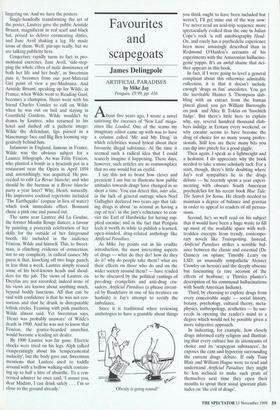So close to the ground
William Feaver
TOULOUSE-LAUTREC AND THE FIN-DE-SIECLE by David Sweetman Hodder, £25, pp. 511
The shortness of Henri Toulouse- Lautrec has been exaggerated. True, Peter Sellers playing Inspector Clouseau cun- ningly disguised as the genius of old Mont- martre was spoofing Jose Ferrer in Moulin Rouge rather than the artist himself. Even so, parody is part of the myth: the tiny toff from the Midi discovering night life in gay Paree, catching the whores yawning as they wait for customers in the maison de tolerance, drawing the tawdriness behind the oo-la-la at the Chat Noir, the dark beyond the garters.
The temptation is to extrapolate from sexual commerce to the body politic, and David Sweetman zooms enthusiastically from thighs to zeitgeist. In his account of the life and times of Henri, as he calls him, he makes the necessary preliminary adjust- ments, deconstructing the family name put together by the barmy father, the Count Alphonse de Toulouse-Lautrec-Montfa referred to throughout as Alph — and restoring to Henri several inches in height. Then he casts around for telling connec- tions. Following on from the success of his biographies of Van Gogh and Gauguin, he obviously wanted to deliver a fresh Lautrec for the 1990s. Engaging though it is, the book fails to convince.
Medically, Sweetman has nothing to offer beyond restated opinions. What was wrong with Lautrec? Was it osteogenesis imperfecta or polypiphysial dysphasia or lipochondrodystrophy? Hard to say. Clear- ly, minor-aristocratic inbreeding was involved, for dwarfism (pycrodysostosis) was rife in the cousinage. Heir to cripple- dom, pickled in absinthe, riddled with syphilis, the unfortunate Henri died in 1901 aged 36. The incurability of syphilis invites comparisons with the scourge of Aids a century later, of course, and Sweetman stresses the parallels. He also argues that Lautrec was not immune to the radical impulses of the age. This is hardly surpris- ing but it leads him into increasingly implausible speculation. He links Lautrec with Oscar Wilde and Felix Feneon, editor, critic and alleged bomb-planter, drawing the three together and binding them into sympathy with one another. His evidence is largely circumstantial but it fills the book engagingly, proliferating like snaky art- nouveau tendrils.
Paris is the scene, racily sketched in. 'The aroma of all this super-naughtiness', in Sickert's phrase, never fails to wrinkle the reader's nose. As fins-de-siècle go, the 1890s went off pretty well. We have the fizz and bang of anarchist activities, the grind- ing tectonic plates of empire pressing against empire, reform movements, reactionary irritants, l'Affaire Dreyfus
Toulouse-Lautrec with one of his models in hoot of 'Ali .soloo de to foe des Moiilhns'. (Muscle Toulouse-Lazo n-, A Ma
lingering on. And we have the posters.
Single-handedly transforming the art of the poster, Lautrec gave the public Aristide Bruant, magnificent in red scarf and black hat, poised to deliver coruscating ditties, and Jane Avril shaking a leg. He made icons of them. Well, pin-ups really, but we are talking publicity here.
Conjecture rapidly turns to fact in pro- motional exercises. Jane Avril, 'side-step- ping the whole ethos of male dominance of both her life and her body', as Sweetman puts it, becomes from our post-Material Girl point of view a pre-Madonna. And Aristide Bruant, speaking up for Wilde, in France, when Wilde went to Reading Gaol, becomes a champion. Henri went with his friend Charles Conder to call on Wilde when he was out on bail and staying in Courtfield Gardens. Wilde wouldn't be drawn by Lautrec, who returned to his hotel and dashed off a pathetic image: Wilde the defendant, lips pursed in a blancmange face and Big Ben looming sug- gestively behind him.
Infamous in England, famous in France, Wilde was the obvious subject for a Lautrec lithograph. As was Felix Feneon, who planted a bomb in a hyacinth pot in a restaurant near the Opera in April 1894 and, astonishingly, was acquitted. He pro- ceeded to edit La Revue blanche; and who should be the barman at a Revue blanche party a year later? Why, Henri, naturally. His impressive cocktail repertoire included The Earthquake' (cognac in lieu of water) which took immediate effect. Bonnard chose a pink one and passed out.
The same year Lautrec did La Goulue, the former Moulin Rouge dancer, a favour by painting a posterish celebration of her skills for the outside of her fairground booth. He included in the audience Feneon, Wilde and himself. This, to Sweet- man, is clinching evidence of connection, not to say complicity, in radical causes. My guess is that, knocking off two huge panels in less than a week, Lautrec simply reused some of his best-known heads and shoul- ders for the job. The views of Lautrec on Dreyfus are not recorded; indeed none of his views are known about anything much, beyond bodily functions. All that can be said with confidence is that he was not cen- sorious and that he drank in disreputable leftish circles. Feasting with pink panthers, Wilde almost said. Yet Sweetman says, `Henri was probably unaware' of Wilde's death in 1900. And he was not to know that Feneon, the goatee-bearded anarchist, would become a leading art dealer.
By 1900 Lautrec was far gone. Electric shocks were tried on his legs. Alph talked exasperatingly about his 'temperamental audacity', but the body gave out. Sweetman mentions that Lautrec used to toddle around with a hollow walking-stick contain- ing up to half a litre of absinthe. To a con- cerned admirer he once said, 'I assure you, dear Madam, I can drink safely . . . I'm so close to the ground already.'



























































































 Previous page
Previous page